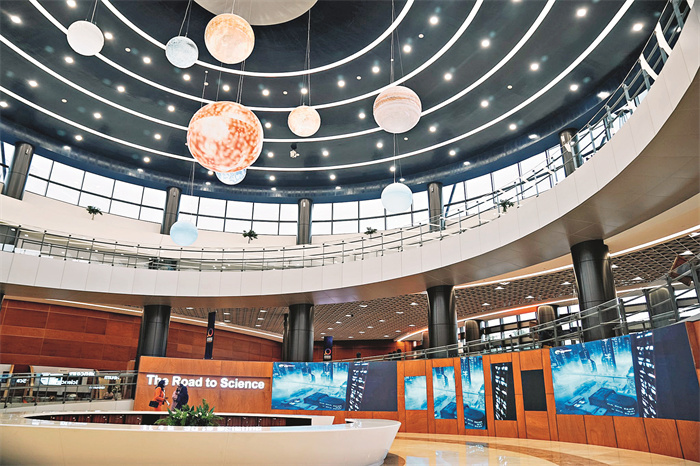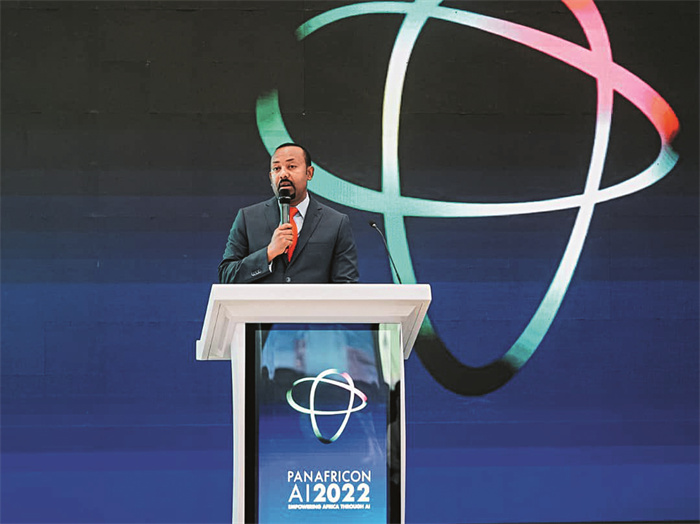|
||||||||||
| Home Nation World Business Opinion Lifestyle ChinAfrica Multimedia Columnists Documents Special Reports |
|
||||||||||
| Home Nation World Business Opinion Lifestyle ChinAfrica Multimedia Columnists Documents Special Reports |
| ChinAfrica |
| Popularising Science |
| Ethiopia opens state-of-the-art science museum to promote technology and innovation |
| Reporting from Ethiopia Henok Terecha 丨VOL. 15 January 2023 ·2023-01-09 |

A view of the museum interior
Ethiopia has inaugurated Africa’s first ever multipurpose science museum in the capital Addis Ababa, with an aim of creating a centre of excellence for innovation. The Chinese government-aided state-of-the-art science museum, the Ethiopia Museum of Art and Science, is part of the country’s digital transformation and development endeavours. The facility was inaugurated in October 2022, on the sidelines of the First Pan-African Conference on Artificial Intelligence, and is Africa’s first ever science museum.
The solar energy source museum is acclaimed as evidence of progress towards envisioning the future of technology in the continent’s digital transformation. Surrounded by a greenery compound, the museum complex covers 7 hectares and hosts two major building complexes. Speaking at the inaugural ceremony, Ethiopian Prime Minister Abiy Ahmed said the museum serves as a platform where scientific innovation will be conceived and born to support the growth and development of Ethiopia.
The visually stunning dome-shaped museum aims to help promote science and innovative activities in the country, while serving as a centre for different research activities related to the digital sector. But perhaps more importantly, the museum is expected to incubate youth and offer a unique venue for young minds to inquire, explore, and invent.
More than half of the museum is owned by the government’s Ethio Telecom, the country’s telecommunications giant, which built various infrastructures that support the museum’s activities. Ethio Telecom’s Chief Communications Officer Mesay Woubshet told ChinAfrica that the museum can provide technology-based facilities for different sectors such as mining, tourism, education, transportation and housing.
Hub for research and technology
Although the museum has a heavy focus on becoming a centre for new research and innovative products developed by youth, it also provides different educational facilities to students in different age groups, with access to smart education. According to Woubshet, this will enable the country to be competitive globally through building a generation that can make a difference in science and technology.
“We have done a lot to add different ingredients that will help to train young people in robotics and other technology-based education,” said Woubshet.
“Besides, by boosting the scientific skills of the youth, the museum allows entrepreneurs to bring their creative products to life by supporting them with equipment that will enhance them practically,” he added.
ChinAfrica spoke to museum visitor, 17-year-old Saron Abraham, who has a big interest in robotics. She said she saw many interesting things in the museum, starting from its mesmerising architectural design. “The different technologies I visited inspired me to think about the future, and to develop new ideas related to scientific findings and technologies.”
Although Abraham has asked her parents to enrol her in robotics school, they were not able to afford the fees. “I hope the museum will help me to get closer to my interest and I will use this opportunity properly to expand my skills on science and technology,” she said. She also believes that the museum inspires more young people to be researchers and innovators by helping them to practise what they have learned in theory at school. However, she wants the museum to be linked with schools so that students will get easy access to practical exercises.
Tewodros Demise, a student at Addis Ababa Institute of Technology, was also impressed with the museum. For him the benefit of the museum is manifold. “It will help me to focus on creativity and innovation, and it will add value to my academic knowledge,” said Demise.
In recent years many Ethiopian youths have shown interest in space science. On 6 September, three Chinese astronauts, or taikonauts, spoke to youth from eight African countries, including Ethiopia, from their space station via video link. The taikonauts, who are on a six-month mission, shared their experience about life on the Shenzhou-14 mission. The linkup, held at the African Union Commission Headquarters in Addis Ababa, was the first time that China and the African Union have co-hosted a space-Earth connection targeting African youth.
On the occasion, the African youth asked the taikonauts various questions about life in space and were entranced by their experiences.

Ethiopian Prime Minister Abiy Ahmed speaks during the First Pan- African Conference on Artificial Intelligence held at the museum on 4 October
Digital ambition
Ethiopia has a 10-year Digital Economy Strategy, which began implementation two years ago. As a testimony to the country’s commitment to the sector, Prime Minister Ahmed described the museum as a demonstration of Ethiopia’s attention to science and technology. The prime minister also expressed hope that the museum will encourage young people to think creatively and utilise the space as a “breeding ground for innovative ideas.”
Many stakeholders believe the museum will serve a pivotal role for the country’s digital transformation strategies by bringing digital solutions to communities. Woubshet noted that the museum’s digital facilities, installed by Ethio Telecom, will assist the development of sensitive sectors such as transportation and health, through the use of 5G network, with the latest technology-based gaming experience for different age groups.
The inauguration of the museum featured an exhibition of government institutions such as Ethio Telecom, Artificial Intelligence Institute, and Information Network Security Agency, along with private technology startups showcasing some of the country’s home-grown solutions in healthcare, finance, cyber-security, geographic information systems, service industries, data analytics, manufacturing, and robotics among others.
Hailed as one of the largest museums in Africa, the government aims to generate income from visitors in the coming years, in addition to its contributions to astronomy, geology, science, among others.
The museum building has different sections that are used to serve educational and research purposes, each with its unique subjects and presentations, which allows researchers to use laboratories with different types of equipment.
Worku Gachena, director general of the Ethiopian Artificial Intelligence Centre, told Xinhua News Agency that the government of China is not only helping Ethiopia to acquire such a state-of-the-art museum, but also empowering Ethiopian experts in artificial intelligence.
“We have signed a memorandum of understanding with the Chinese government especially to work with them on optical character recognition for African languages. The Chinese have been very supportive of artificial intelligence in capacity building in education and other sectors,” said Gachena.
| About Us | Contact Us | Advertise with Us | Subscribe |
| Copyright Beijing Review All rights reserved 京ICP备08005356号-5 京公网安备110102005860号 |